- Home
- About Us
- Join/Renew
- Member Benefits
- Member Pages
- Log In
- Help
- Museum Store
The owner of this 1914 Pierce-Arrow was an active participant of motorsports. He begun with motorcycles. He owned both Henderson and Indian. He acquired the Pierce in 1919 – after the WW-1. So I believe this was a used car – from France?
In 1921 the owner, Herman Oppen, participated in the first road rally in Norway after the war. It had a distance of 580 kilometer (362 miles) and they were driving over the night. In addition to the road rally he also was active in hill climbing competition with the car. The photo is from the start of the rally in 1921.

In Scandinavia both Danmark and Norway did always have the same system as you have in US – driving on the right side of the road. In Sweden they drove the cars on the left side as they still do in England. In 1967 Sweden switched the side. In those days there was a joke in Norway before the swede switched over: They tested out the right hand system first by trying buses and trucks drive on the right side…
Many manufactorers of cars produced cars with right hand steering in the beginning, as also Pierce-Arrow did. The customer in fact did not have any choice. See the enclosed photo of an old Pierce in Norway.
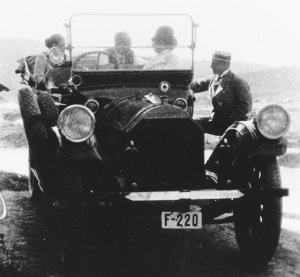
Fay,
Also from Norway we want to congratulate the receiving of the Award. Enclosed is a photo from 1995 when you visited us in Norway and made a speach and a seminar.
Oivind and Trygve
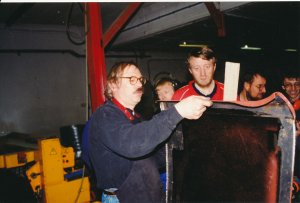
The hearse is a 1927 model and was converted from a taxi. Enclosed is a bad photo of the taxi, scanned from an old magazine. The car belonged to a town north in Sweden – Hudiksvall.
The next one belonged to Stockholm, the Capitol of Sweden. I think I have some more information on this car. I will come back on that!
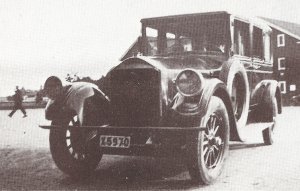
I have checked it out. Sorry to say that but the comedian after a day did not allowed to show the clip on youtube. Here is a photo instead.
Oivind
Thank you for the information Bob.
I learned about that in the Long Clutch Bulletin and did as described. So far the clutch is now working fine.
Sincerely,
Oivind in Norway
Well installed I made a litte wood tool as alignment fixture to get the wright distance from the end of the splined hub an the 6 release lever tips. This should be 1 1/16″.”
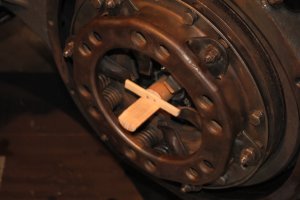
Here is the correct way to assemble the cover plate assembly.
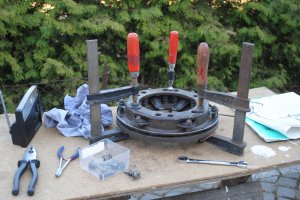
Now I have enstalled 4 new friction facing with the correct thickness of .130″ – infact I got it free from the shop. The four they installed last year was to thick.
I also disassembled the cover plate both to check the springs and also straitend the stamped steel cover plate.”

Does anyone of you have some spare clutch parts like the cover plate (only)? May be I can have it straghten but it will most likely never be 100%.
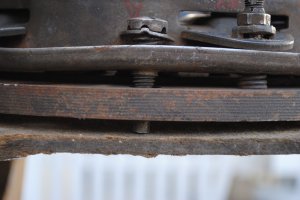
The thickness of the friction facing of my clutch was almost .2″. I now have to ground down the faces to the correct thickness.
Unfortuneatly I also found that the coverplate (photo) was not even on two different places – downside (see next photo).”
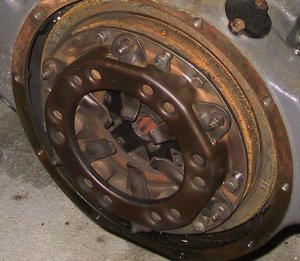
Thank you for that important information, Bill. I look forward to check it out!
Oivind
Thanks to all of you !
I have the PASB 73-5 which contents the Clutch Service Manual for the Long Clutch (model 29 AM) – 4 pages. There are plenty of adjustment advices and distances but no thickness measurement for the Friction Facing as far as I have observed.
transmission?
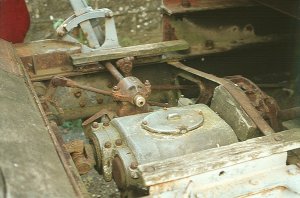
Engine
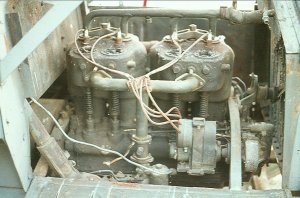
Hi Tony,
The car is an Apollo 1910, produced by A. Ruppe & Sohn (1903 – 1927) in Germany. It is a friend behind the wheel, I was only Co-pilot. New leather straps were under production, therefore the rope! The car is air cooled.
If you take a close look on the rear wheel you can see “tire chains””. I only used a strong and thick rope which in fact made it possible to drive quite normally. The tire I have are like racing slicks… Without chains it would have been impossible to drive on snow.
This picture was taken some years back. It was sunday morning before they came with ther snow plow and the salt.
In Oslo we have a tradition to drive on January 1 up to a little mountain close to the city. You have to drive an open antique car and at the at the goal you have to eat an icecream outdoor…! I planned to go this year but the road was allraedy destroyed by salt. The photo is from last “”snow rally””.”
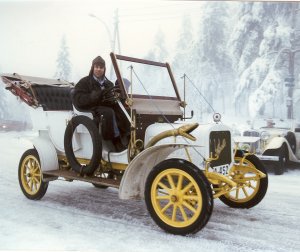
Did anybody speak of snow and Pierce-Arrow?
My experience with the High Speed Rear Axle is in fact that my Pierce is using about 15% less gasoline. 320 miles test last summer as to the same trip in 2006.
A problem is when I am driving at a speed of 80 km/h (50 miles) the odometer is showing about 60 km/h (37.5 miles). Many of you must have had the same problem. Have anybody the solution?

Sorry wrong photo!

